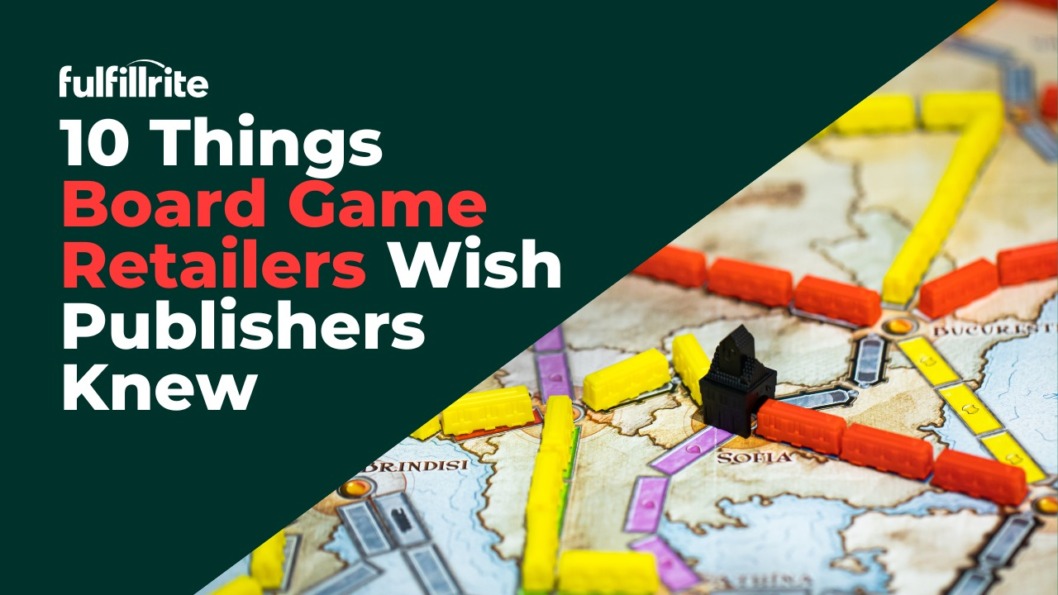Getting your board game in stores isn’t just about making a great product—it’s about understanding how retailers think. At GAMA Expo 2025, a board game convention for industry folks in the know, I sat in on a panel called Things Retailers Wish Publishers Knew.
The panel featured Andrea Robertson of Rain City Games, Kylie Primus of Games Unlimited, and Courtney Hartley of Bonus Round Café.
Each panelist brought a different perspective—from traditional hobby stores to game cafés that focus on teaching and playing. What they all had in common: years of experience figuring out what sells, what sits on shelves, and what frustrates the people doing the selling.
In this post, we’ve pulled together 10 key takeaways from the conversation. If you’re a publisher looking to build strong retail relationships and actually move units, this is a must-read.
Getting your board game in stores successfully starts with listening.
1. Retailers Get More Email Than They Can Answer
Retailers get buried in emails—Kylie mentioned getting 64 solicitations in a single week. If they didn’t ask for it, chances are it’s going to spam or a filtered folder they might check once a week.
And even if it gets seen, many emails say the same thing or offer no clear next step. What retailers want is simple: clarity and action. Can they order now? Can they flag a reminder? Is there a direct link?
One retailer said, “If I can’t do something about this now, I’m not going to remember your game in November.”
Sending multiple emails about the same game without adding anything new can actually turn them off. So before you hit send, ask yourself: is there a clear reason for this email to exist? If not, it’s just adding to the noise.
Tip: If your email doesn’t give the retailer a clear action they can take, rewrite it so that it does.
2. Retailers Learn About New Games The Same Way Players Do
Solicitations are just one piece of the puzzle—and they’re not exactly as important as a corner piece in a traditional puzzle. You might be surprised to hear that retailers learn about new games the same way players do: conventions, staff picks, reviews, customer requests, and social media buzz.
A game that comes recommended by staff, gets demoed at a convention, and shows up in multiple places is much more likely to get on the radar. One retailer said they rely on a staff member who “watches pretty much every board game review podcast there is,” while another emphasized listening to customer chatter.
Going after multiple touchpoints matters. Being seen more than once builds interest and credibility. You can’t rely on one email to carry all the weight.
Tip: Think like a marketer—frequency builds familiarity. One email won’t do it.
3. Packaging Needs To Be Practical
If your box doesn’t tell the story, the game won’t sell. Retailers want customers to pick up the game and immediately understand what it is and whether it’s for them.
That means a strong back-of-box layout with visuals of what the game looks like on the table—one retailer said they’d flip a box over and be forced to pull up BoardGameGeek just to explain what it is. That’s a lost sale waiting to happen.
“Can your demo team sell the game using just the back of the box?” one panelist asked. If not, something’s missing. The sides of the box matter too—many stores shelve spine-out, not face-out. If the game name isn’t visible, it gets ignored.
Non-standard box sizes also create headaches. “If it doesn’t fit on the shelf, it goes on top… and no one sees it.”
Tip: Ask your demo team to try selling the game only using the box. If they can’t, fix the box.
4. Release Timing: Avoid the Holiday Black Hole
If your game hits shelves between mid-October and mid-January, it’s likely to be ignored. Retailers are swamped—managing inventory, restocks, holiday traffic, and end-of-year admin.
“Anything we get during that window is probably never going to be seen,” said one panelist. That doesn’t mean the game won’t sell at all—but retailers won’t have the time to learn, demo, or actively promote it. Exceptions are titles they’ve already preordered or expansions to games with a strong existing presence.
For everything else, timing is critical. Want to make a push for the holidays? Hit retailers in September or early October with a short list of your top games to stock. Make it easy to pick, easy to order, and ideally, easy to sell.
Tip: September and early October are ideal for pitching holiday titles. Send a clear list of your top 3 SKUs—make their job easier.
5. Direct Sales: Some Do It, Many Don’t
Some retailers will order directly from your website. Others won’t touch direct ordering at all. The reasons vary—time, logistics, staffing, and habit. “I love ordering direct,” one panelist said, “but a lot of stores are too small or too busy to manage it.”
Offering direct ordering is still worth doing—but don’t assume all retailers will use it. You need to offer multiple paths: distribution, direct sales, preorder portals, bundles, whatever works. Just avoid bundle structures that force a 1:1 ratio of base games to expansions—that causes inventory headaches.
And never assume what “every retailer” will or won’t do. As one panelist put it, “Retail is not homogenous. If someone tells you no store will ever do X, ignore that advice.”
Tip: Offer multiple options for ordering. Even if only a few stores use them, those few may be your champions.
6. Be Smart About Expansions
Retailers are cautious with expansions—especially for games they haven’t sold before. If the base game has a proven track record or an active local fanbase, bringing in expansions makes sense. But if the game is new to the store, most retailers will only take a chance on the core box.
One panelist explained they’ll sometimes bring in expansions at a 2:1 or 3:1 ratio to base games—but only when demand is already there. Packaging matters too. If the expansion comes in a blister pack or small format that has to hang far away from the base game, it might not sell at all. Ideally, the expansion should shelve next to the original—clean, simple, and obvious.
Tip: Don’t bundle expansions in ways that force retailers to sell them with the base game. Give them flexibility.
7. Know Your Pricing Sweet Spots
If you’re pricing a game for retail, the consensus was that $40 is a magic number. That’s the average ticket price in many stores, and it’s what customers are most comfortable spending on a casual visit.
Games around $70 are still viable but need to justify the cost—retailers will hesitate unless they already believe in the title. And once you cross into triple-digit pricing, the sales drop significantly.
Games at $100+ need to be special to move. Meanwhile, sub-$20 games fall into impulse-buy territory, especially if they’re easy to demo or explain.
Licensing complicates this: if adding an IP pushes a $35 game up to $50, you’ll lose customers who like the brand but not enough to pay a premium.
Tip: Price smart. IPs that inflate cost too much can tank sales, even if the game’s good.
8. Respect the Game Café
Game cafés aren’t just places to play—they’re powerful sales channels. A demo copy in a café might get played dozens or even hundreds of times. That kind of exposure builds familiarity and turns casual players into buyers.
But publishers often overlook cafés or saddle them with case minimums to access demo copies. That’s a mistake. One panelist explained that cafés act as long-tail ambassadors, especially for evergreen titles.
They don’t want free product—they want a fair way to buy demos without hoops. And they need them at the same time as the sellable inventory, not weeks later. If you wait, they’ll open a sellable copy themselves. That’s one fewer game on the shelf, just because you didn’t ship things together.
Tip: Let cafés buy demos at a discount with no hoops. It pays off long-term.
9. Promos & Marketing Materials: Tread Carefully
Promos can help—but only if they’re handled right. If a publisher advertises a promo item and the store doesn’t have it, customers may walk away. “Do you have the promo?” is a question that can cost a sale. And if the retailer didn’t even know a promo existed, that sale’s gone.
Materials matter too. Posters are hit or miss. Many cafés and premium stores want clean aesthetics—bold or poorly designed posters won’t go on the wall. What works better? Coasters, clever leave-behinds, and materials that feel native to the space.
Café owner, Courtney Hartley, suggested dual-purpose materials: evergreen on one side, new product on the other. Don’t just print and ship stuff—think about where it’s going and whether it will actually get used.
Tip: Make promos store-friendly, and offer marketing materials that actually suit the store type.
10. Final Advice: Just Talk to Retailers
There’s no substitute for a real relationship. GAMA panels are great, but one-on-one conversations are better.
Want to know how your packaging lands? Ask.
Want to see if your bundle structure works? Ask.
Some publishers do this well—reaching out to trusted stores for a private Zoom or quick call with their team. Those sessions are invaluable. Just be respectful of time.
Cold calls won’t get you far, and walking in unannounced during peak hours is a sure way to get ignored. Build relationships early, and keep them going between shows. It’s worth it.
Tip: Pick 3–5 retailers to build real rapport with. Zoom calls go a long way.
Final Thoughts
Retail is messy, inconsistent, and deeply human. No two stores run the same way, and no one approach works for every buyer. That’s not a flaw—it’s the reality of selling games through people instead of algorithms.
If you want to succeed in retail, you need more than a great game. You need to think like a partner. Make things easier, not harder. Stay curious. Listen more than you pitch.
And remember that retailers aren’t gatekeepers—they’re allies. Their feedback isn’t just critique — it’s insight into what actually moves units in the real world.

